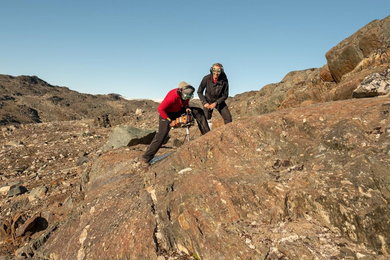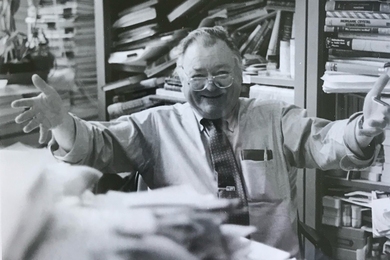The creative process — whether the end result is a movie, a television program, or future technologies — is a bit like driving through the fog, producer-writer-director J.J. Abrams said in a talk Tuesday at the MIT Media Lab. Abrams is the creator of the television series “Lost” and “Revolution” and director of a “Star Trek” sequel to be released next year.
Abrams explained that in the creative process, one often has a sense of one’s destination, but the journey may end up taking some surprising twists and turns. When he’s on the set, he says, even though the dialog is established, once the performance starts sometimes “you have to let it go, and see where it takes you. You can’t anticipate everything.”
Abrams spoke after a tour of the Media Lab with its director, Joi Ito, as part of the lab’s series of “Conversations,” informal talks that are webcast live.
“This place opens and expands your mind,” Abrams said. “It opens doors you didn’t know existed.”
Abrams joked that his visit to the Media Lab reminded him of many scripts he’s written about mysterious people working in secret laboratories. The creator of these mad scientists with malevolent plans or twisted psyches apologized to the researchers arrayed before him: “To anyone who is a scientist, all I can say is, ‘I’m sorry!’” Humbled by the research he observed at the lab, he added, “I’ve never felt dumber than I do now.”
Asked about the secrecy that often surrounds his projects, Abrams explained, “It’s not a ploy, or being coy.” Rather, he said, it stems from his feelings, as a moviegoer and TV viewer, that too much advance discussion of movies or shows can really detract from the enjoyment. “We do it to make the experience better for viewers,” he said.
Open views
Abrams said that in some ways, the building that houses his production company, Bad Robot, resembles the Media Lab, where open, glass-walled labs allow a view of what everyone else is working on. At Bad Robot, he said, teams also work in glass-walled spaces to encourage a spirit of sharing and collaboration. “It is eerily similar, in some respects,” he said.
To encourage creativity, even the waiting rooms at Bad Robot have tables covered with paper and markers, instead of piles of old magazines. “It’s not a place to read, it’s a place to create,” he said.
One example of letting the story take off in unexpected directions, Abrams said, was in the making of “Lost,” where Ben Linus was initially written as a one-episode character. But Abrams’ co-creator, Damon Lindeloff, “realized this guy is a much more important character,” and he ended up becoming quite central to the last few years of the series.
By sticking to the plan, Abrams said, the story would have been much less interesting. Sometimes, he said, someone who becomes your favorite character “was just a brushstroke in the script.”
But sometimes things go in the other direction, he said: Someone who was supposed to be a major character “for whatever reason, isn’t doing what you expected.” In the original storyline, “you knew that the end of the season was going to be a big reveal for that character.” But if things aren’t working out, he said with a shrug, “you realize you’ve got to kill him.”
In fact, Abrams said, he feels “there’s nothing worse than going into a meeting where you expect things to go a certain way, and having it go that way.”
Evolving things
“When you’re driving in the fog, you know where you’re going, but suddenly you realize there’s a giant canyon you have to go around,” he said. Creativity “is organic, it’s an evolving thing.”
Ito said that’s much like the process often followed at the Media Lab, where serendipity is key: “We figure out the questions, sometimes, after we figure out the answers.”
Abrams said that in general, he doesn’t think the medium — whether a program is viewed on a television or a laptop — makes much difference. It’s the storytelling that matters, he said.
But, he added, there are some important differences. “I’m excited about doing things for cable,” a medium that averts the limitations imposed by commercial breaks. Because of the need to end each segment with a dramatic cliffhanger — something for which his programs are known — “it’s a cart-before-the-horse way of storytelling. You have to build this unnatural dramatic moment imposed by the structure, not by the story.”
In the end, Abrams said, whether he’s creating a character, a scene, or a storyline, the key to knowing when something is working well is in the way it makes him feel: “How do I know? Because I get chills!”
People today have become jaded and suspicious, Abrams said, because special effects and computer-generated images have become so sophisticated that it’s hard to create a feeling of amazement anymore. “Part of my job is to be able to re-mystify things,” he said.






